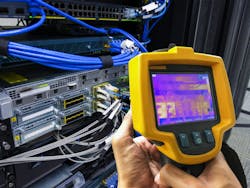Artificial Intelligence (AI) is fundamentally reshaping the landscape of digital infrastructure. The exponential growth in AI applications is driving demand for compute to unprecedented levels. This presents a significant challenge for data center operators, who must navigate the delicate balance between maintaining efficiency, sustainability, and total cost of ownership (TCO) in the face of escalating demand.
Cooling AI workloads poses a significant challenge for data centers. Currently, cooling data center infrastructure alone consumes about 40% of an operator's energy usage. With the projected exponential growth of the AI industry, the International Energy Agency (IEA) anticipates a tenfold increase in energy demand by 2026 compared to 2023. This rapid expansion places immense pressure on data center operators to swiftly adapt and innovate to keep pace with the evolving demands of the digital era.
Next-generation CPUs and GPUs are being tasked with handling AI’s increasingly complex algorithms and massive datasets. These workloads generate substantial heat with thermal design power (TDP) requirements of up to 1500W and beyond, necessitating efficient cooling systems to maintain optimal operating temperatures. As a result, data center operators will be looking more urgently to future-proof their infrastructure investments.
Liquid cooling is emerging as a vital technology for AI workloads by optimizing performance, energy efficiency, and hardware reliability in AI-driven data center environments. It is a revolutionary approach to dissipating heat from high-powered computing and denser hardware configurations. Liquid cooling addresses the thermal challenges of AI and enhances overall data center efficiency and sustainability, positioning itself as a cornerstone technology for modern data centers.
Efficiently dissipating heat by circulating a dielectric coolant directly over the hottest components, liquid cooling ensures optimal operating temperatures for AI systems while reducing carbon emissions and overall energy consumption. However, not all liquid cooling technologies are equal.
Cold plate and immersive technologies, available in single-phase and two-phase processes, are well known within the industry. Cold plate cooling, or direct-to-chip cooling, excels in delivering peak cooling performance at the chip level but still relies on auxiliary air cooling and may not fully address long-term sustainability objectives.
Conversely, tank immersion offers a sustainable alternative, potentially eliminating the need for fans in data centers and enabling the recapture and reuse of nearly 100% of the heat. However, its implementation often requires new facility designs and structural adjustments, posing challenges in existing brownfield data center spaces. Also, serviceability challenges make maintenance and data center operations challenging.
Among today’s cooling technologies, Precision Liquid Cooling is a third alternative that stands out as the simplest and most efficient option available. Combining the benefits of direct-to-chip and tank immersion, Precision Liquid Cooling delivers a small amount of dielectric coolant, precisely targeting the removal of heat from the server's hottest components as well as the entire system within the chassis. This ensures maximum efficiency and reliability, removing nearly 100% of the heat generated across the entire IT stack while reducing energy use by up to 40% and water consumption by up to 100%.
Data center operators are navigating the complexities of AI's impact on infrastructure in real-time. Amidst the tension between power, sustainability, and data center growth, innovative solutions are crucial to effectively address these challenges. Liquid cooling is one such solution. To be successful it will require collaborative efforts between data center design and build teams, IT specialists, and executive leadership to seamlessly integrate liquid cooling into data center environments. By aligning liquid cooling strategies with broader business objectives, organizations can accelerate innovation, improve cost-effectiveness, and gain a competitive edge in the AI-driven era.
About the Author

Nathan Blom
Nathan Blom is the Chief Commercial Officer of Iceotope Technologies where he is responsible for managing external partnerships, go-to-market strategy, revenue management and product positioning. Iceotope is reimagining data center cooling from the cloud to the edge. Using industry standard form factors, Iceotope’s Precision Liquid Cooling solutions offer extreme cooling performance, simplified maintenance, and significant cost reductions.



